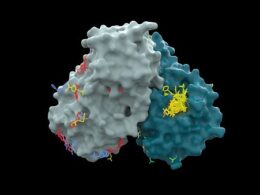Data on viral levels point to immune evasion as a cause of the variant’s transmissibility.
Nature
Max Kozlov
19 January 2022
A hospital worker in Bochum, Germany, cares for a person with COVID-19 at the start of Germany’s Omicron-fuelled wave.Credit: Ina Fassbender/AFP/Getty
The Executive Summary below was edited by the author of the blog, as a voluntary christian service, to reach out in particular the Brazilian population. For the full version of the article, please refer to the 2nd part of this post.
SmartHealth blog, January 23 2022
Joaquim Cardoso MSc. (Chief Editor)
Executive Summary
What are the new findings about Omicron?
- Two studies show that the Omicrom variant has achieved success despite causing viral levels in the body that are similar to — or lower than — those of its main competitor, the Delta variant,.
- The results suggest that Omicron’s hyper-transmissibility does not stem from the release of large amounts of virus from infected people.
- Instead, the best explanation for its lightning-fast spread is its ability to evade SARS-CoV-2 immunity caused by either vaccination or past infection
What are the implications of these findings?
- The findings have implications for government policies on isolation after infection.
- … about half of the samples still held infectious virus five days after the individuals tested positive.
- Such results are concerning, Grad says, because guidelines published by the CDC allow people infected with the virus to end their isolation five days after either testing positive or experiencing their first symptoms.
- The guidelines specify that people who have exited isolation must continue to wear a mask around others for five more days, but do not require a negative COVID-19 test to end isolation.
- The CDC did not respond to Nature with any comment by press time.

In countries around the world, Omicron has rapidly surged past other variants to become the dominant SARS-CoV-2 strain.
Now, two studies show that the variant has achieved success despite causing viral levels in the body that are similar to — or lower than — those of its main competitor, the Delta variant,.
The results suggest that Omicron’s hyper-transmissibility does not stem from the release of large amounts of virus from infected people.
Instead, the best explanation for its lightning-fast spread is its ability to evade SARS-CoV-2 immunity caused by either vaccination or past infection, says Emily Bruce, a virologist at the University of Vermont in Burlington.
The studies have not yet been peer reviewed.
Heavy load
Previous research has hinted that, compared with infections earlier in the pandemic, Delta-variant infections lead to a higher ‘viral load’, the amount of virus in an infected person.
This is often measured using a polymerase chain reaction (PCR) test, which provides an index of the quantity of viral RNA in the body.
To compare the viral loads linked to the ever-changing cast of SARS-CoV-2 variants, Yonatan Grad, an infectious-disease specialist at the Harvard T. H. Chan School of Public Health in Boston, Massachusetts, and his co-authors drew on data from the National Basketball Association, the organization responsible for professional basketball in North America.
The league conducts frequent COVID-19 testing of its players and personnel.
The researchers studied PCR-test results of nose and throat swabs collected from infected individuals and found that those who had Delta had a slightly higher peak viral load than did those with Omicron.
“I was really not expecting to see that,” says Grad. After all, in only two months, Omicron replaced Delta as the dominant cause of US COVID-19 cases.
Benjamin Meyer, a virologist at the University of Geneva in Switzerland, says he too was stunned by Grad’s results. “Naturally, you’d think that higher transmissibility must cause a higher viral load,” he says.
Meyer and his colleagues took the study a step farther: rather than measuring only viral RNA, they also measured the number of infectious virus particles on swabs collected from a separate group of almost 150 infected people.
This more stringent method found no significant difference between the viral loads of vaccinated individuals infected with Omicron and those infected with Delta.
Isolation exit
The findings have implications for government policies on isolation after infection.
Meyer’s team examined samples from people who had been vaccinated but nonetheless became infected with Delta.
They found that about half of the samples still held infectious virus five days after the individuals tested positive.
Grad and his colleagues found that five days after an initial positive test for Omicron, about half of tested individuals had viral loads high enough that they were probably still infectious.
Grad and his colleagues found that five days after an initial positive test for Omicron, about half of tested individuals had viral loads high enough that they were probably still infectious.
Such results are concerning, Grad says, because guidelines published by the US Centers for Disease Control and Prevention (CDC) allow people infected with the virus to end their isolation five days after either testing positive or experiencing their first symptoms.
The guidelines specify that people who have exited isolation must continue to wear a mask around others for five more days, but do not require a negative COVID-19 test to end isolation.
Such results are concerning, Grad says, because guidelines published by the CDC allow people infected with the virus to end their isolation five days after either testing positive or experiencing their first symptoms.
The CDC did not respond to Nature with any comment by press time.
Omicron has made public-health decisions all the more difficult, Grad says.
He and his colleagues also found more variability in viral load in individuals infected with Omicron than in people infected with Delta. “That means there’s no clear ‘one size fits all’ approach,” he says.
Omicron has made public-health decisions all the more difficult, Grad says.
doi: https://doi.org/10.1038/d41586-022-00129-z
Originally published at https://www.nature.com.
Names cited
Emily Bruce, a virologist at the University of Vermont in Burlington.
Benjamin Meyer, a virologist at the University of Geneva in Switzerland
Yonatan Grad, an infectious-disease specialist at the Harvard T. H. Chan School of Public Health in Boston, Massachusetts
Nature
Max Kozlov
19 January 2022
A hospital worker in Bochum, Germany, cares for a person with COVID-19 at the start of Germany’s Omicron-fuelled wave.Credit: Ina Fassbender/AFP/Getty
The Executive Summary below was edited by the author of the blog, as a voluntary christian service, to reach out in particular the Brazilian population. For the full version of the article, please refer to the 2nd part of this post.
SmartHealth blog, January 23 2022
Joaquim Cardoso MSc. (Chief Editor)
Executive Summary
What are the new findings about Omicron?
- Two studies show that the Omicrom variant has achieved success despite causing viral levels in the body that are similar to — or lower than — those of its main competitor, the Delta variant,.
- The results suggest that Omicron’s hyper-transmissibility does not stem from the release of large amounts of virus from infected people.
- Instead, the best explanation for its lightning-fast spread is its ability to evade SARS-CoV-2 immunity caused by either vaccination or past infection
What are the implications of these findings?
- The findings have implications for government policies on isolation after infection.
- … about half of the samples still held infectious virus five days after the individuals tested positive.
- Such results are concerning, Grad says, because guidelines published by the CDC allow people infected with the virus to end their isolation five days after either testing positive or experiencing their first symptoms.
- The guidelines specify that people who have exited isolation must continue to wear a mask around others for five more days, but do not require a negative COVID-19 test to end isolation.
- The CDC did not respond to Nature with any comment by press time.
In countries around the world, Omicron has rapidly surged past other variants to become the dominant SARS-CoV-2 strain.
Now, two studies show that the variant has achieved success despite causing viral levels in the body that are similar to — or lower than — those of its main competitor, the Delta variant,.
The results suggest that Omicron’s hyper-transmissibility does not stem from the release of large amounts of virus from infected people.
Instead, the best explanation for its lightning-fast spread is its ability to evade SARS-CoV-2 immunity caused by either vaccination or past infection, says Emily Bruce, a virologist at the University of Vermont in Burlington.
The studies have not yet been peer reviewed.
Heavy load
Previous research has hinted that, compared with infections earlier in the pandemic, Delta-variant infections lead to a higher ‘viral load’, the amount of virus in an infected person.
This is often measured using a polymerase chain reaction (PCR) test, which provides an index of the quantity of viral RNA in the body.
To compare the viral loads linked to the ever-changing cast of SARS-CoV-2 variants, Yonatan Grad, an infectious-disease specialist at the Harvard T. H. Chan School of Public Health in Boston, Massachusetts, and his co-authors drew on data from the National Basketball Association, the organization responsible for professional basketball in North America.
The league conducts frequent COVID-19 testing of its players and personnel.
The researchers studied PCR-test results of nose and throat swabs collected from infected individuals and found that those who had Delta had a slightly higher peak viral load than did those with Omicron.
“I was really not expecting to see that,” says Grad. After all, in only two months, Omicron replaced Delta as the dominant cause of US COVID-19 cases.
Benjamin Meyer, a virologist at the University of Geneva in Switzerland, says he too was stunned by Grad’s results. “Naturally, you’d think that higher transmissibility must cause a higher viral load,” he says.
Meyer and his colleagues took the study a step farther: rather than measuring only viral RNA, they also measured the number of infectious virus particles on swabs collected from a separate group of almost 150 infected people.
This more stringent method found no significant difference between the viral loads of vaccinated individuals infected with Omicron and those infected with Delta.
Isolation exit
The findings have implications for government policies on isolation after infection.
Meyer’s team examined samples from people who had been vaccinated but nonetheless became infected with Delta.
They found that about half of the samples still held infectious virus five days after the individuals tested positive.
Grad and his colleagues found that five days after an initial positive test for Omicron, about half of tested individuals had viral loads high enough that they were probably still infectious.
Grad and his colleagues found that five days after an initial positive test for Omicron, about half of tested individuals had viral loads high enough that they were probably still infectious.
Such results are concerning, Grad says, because guidelines published by the US Centers for Disease Control and Prevention (CDC) allow people infected with the virus to end their isolation five days after either testing positive or experiencing their first symptoms.
The guidelines specify that people who have exited isolation must continue to wear a mask around others for five more days, but do not require a negative COVID-19 test to end isolation.
Such results are concerning, Grad says, because guidelines published by the CDC allow people infected with the virus to end their isolation five days after either testing positive or experiencing their first symptoms.
The CDC did not respond to Nature with any comment by press time.
Omicron has made public-health decisions all the more difficult, Grad says.
He and his colleagues also found more variability in viral load in individuals infected with Omicron than in people infected with Delta. “That means there’s no clear ‘one size fits all’ approach,” he says.
Omicron has made public-health decisions all the more difficult, Grad says.
doi: https://doi.org/10.1038/d41586-022-00129-z
Originally published at https://www.nature.com.
Names cited
Emily Bruce, a virologist at the University of Vermont in Burlington.
Benjamin Meyer, a virologist at the University of Geneva in Switzerland
Yonatan Grad, an infectious-disease specialist at the Harvard T. H. Chan School of Public Health in Boston, Massachusetts












